Schwab's Market Perspective: 2026 Outlook

Listen to this article
Listen to the latest Schwab Market Perspective.
Key takeaways
- The current economic and market cycle is characterized by instability rather than mere uncertainty. Inflation is likely to remain elevated.
- We expect solid returns in fixed income markets in 2026, driven by central bank rate cuts in response to a weakening labor market.
- International stocks could be poised for another strong year as earnings and economic growth are expected to accelerate and international stocks are attractively valued compared with U.S. stocks in the S&P 500® index.
U.S stocks and economy: Instability
The current environment isn't just unclear, it's fluctuating in real time. Uncertain environments still allow forecasters to build somewhat reliable probability models. Unstable environments bring less-reliable probabilities because the underlying relationships are changing in real time. Uncertainty generally assumes unknowns: elections, wars, Federal Reserve decisions, etc. Instability stems from the inner workings of the system itself, such as:
- Tariffs and their uneven application;
- Housing supply frozen because existing homeowners have locked in low mortgage rates and can't move without taking out new mortgages at higher rates;
- Labor supply altered by immigration shifts;
- Fiscal stimulus and deficits decoupling from the business cycle;
- Oscillating inflation components;
- Stock market breadth—how many stocks are participating in an index's move—narrowing and widening in sharper bursts.
It's safe to say that inflation has dominated the post-pandemic economic discourse for multiple reasons. First, the personal consumption expenditures (PCE) price index has been above the Federal Reserve's 2% target for four and a half years. Second, price levels remain well above where they were before the pandemic. Third, there has been upward pressure on inflation from elevated tariffs and a largely resilient services sector.
Going into 2026, we don't see much changing along those lines, especially if there isn't a recessionary-like weakening of the labor market. As shown below, headline PCE (on a year-over-year basis) has edged closer to 3%, with an increasing share of the action driven by demand as opposed to supply. That's a better environment for inflation compared to the supply-driven spike in 2022 and 2023. However, if fiscal aid expands, the labor market holds together, and consumer spending stays on track, there is some upside risk to inflation next year—likely capping the number of Fed rate cuts at two or three.
Persistent inflation
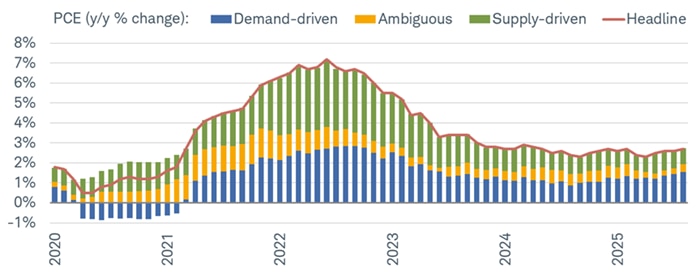
Source: Charles Schwab, Apollo, Bloomberg, Federal Reserve Bank of San Francisco, as of 9/30/2025.
Ambiguous includes items not captured by demand- or supply-driven categories.
A good chunk of that upside risk might be driven by tariffs, which have already lifted prices on consumer goods by a notable magnitude. As shown in the chart below, tariffs have raised overall retail prices by nearly five percentage points relative to the pre-tariff trend. Intuitively, the increase has been sharper for imported goods, but it's worth noting that domestic goods prices have also moved higher. In other words, tariffs are not only impacting prices on goods coming from overseas, but domestic goods as well.
As a reminder, tariffs are taxes on U.S. importers; they are not (repeat, not) paid by exporters in other countries, which is confirmed by the fact that the Import Price Index remains unchanged so far this year. While uncertainty associated with tariff policymaking has subsided in the second half of 2025, we think tariffs will remain a dominant macro theme in 2026. We expect to remain in a high-tariff world, with the average effective tariff rate on U.S. imports still well into double digits. While we think companies will continue to implement cost mitigation efforts (such as low hiring) to avoid steep price increases for the end consumer, there might be thinner profit margins as inventories are worked down.
Tariffs boosting prices
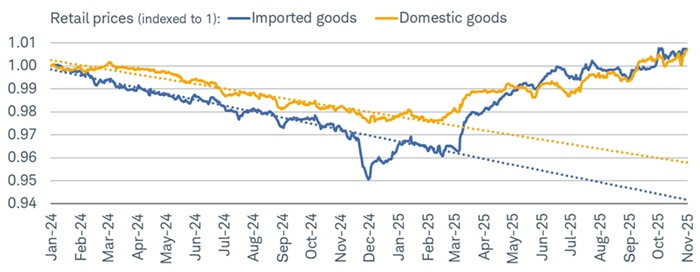
Source: Charles Schwab, Tax Foundation "Tariff Tracker," as of 11/1/2025.
Data indexed to 1 (base value=1/1/2024). An index number is a figure reflecting price or quantity compared with a base value. The base value always has an index number of 1. Dotted lines represent trendlines.
Amid the artificial intelligence (AI) hype and mega caps' increasingly large weight in the indexes, a less-discussed aspect of the market's performance this year has been the lack of multiple expansion in the second half of the year. As you can see in the chart below, the forward earnings per share (EPS) estimate for the S&P 500 has made successive all-time highs since the low earlier this spring. Taking a back seat has been the forward price/earnings (P/E) ratio. In other words, the E has been doing the heavy lifting, which has put downward pressure on the P/E ratio.
In general, an earnings-driven market tends to be healthy and has been much needed this year after multiples got back to cycle (and in some cases, all-time) highs. If forward earnings estimates continue their upward trek, we see the possibility of multiples continuing to move lower heading into 2026. In other words, the market's P/E would be moving down for the so-called right reason (i.e., prices not falling rapidly). That might pave the way for some multiple expansion later in the year, especially if investors continue to have high conviction in the AI space.
Earnings to the rescue
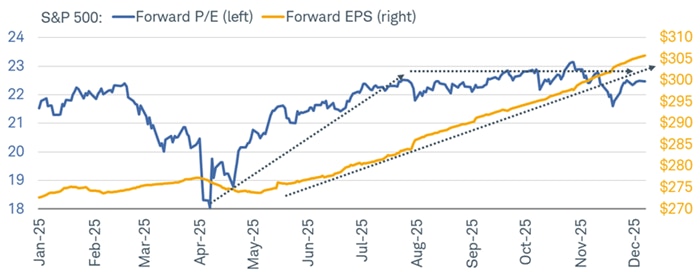
Source: Charles Schwab, Bloomberg, as of 12/5/2025.
Dotted lines for forward P/E show upward trajectory from April-August and sideways trajectory from August-December. Dotted line for forward EPS shows upward trajectory from May-December. Indexes are unmanaged, do not incur management fees, costs and expenses and cannot be invested in directly. Past performance is no guarantee of future results.
Fixed income: A good backdrop
So far 2025 has been a good year in the fixed income markets. Every subcategory we track has posted positive returns year to date, with some in double digits. We expect 2026 to be another good year for fixed income investors. However, yields that are lower than where they were a year ago and less room for rate cuts by central banks likely will mean less-robust returns. Nonetheless, a bias toward easing by major central banks, positive real interest rates (yields adjusted for inflation) and steepening yield curves create a good backdrop for bond investors.
Fixed income year-to-date asset class total returns
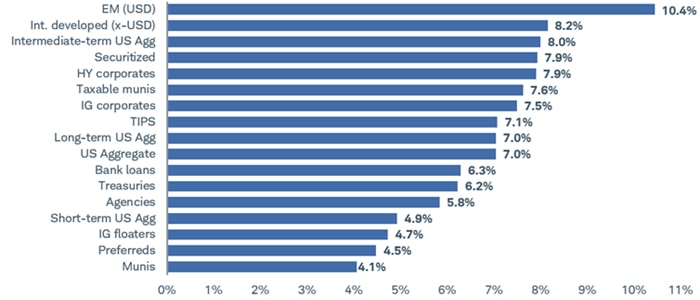
Source: Source: Bloomberg. Total returns from 12/31/2024 through 12/1/2025.
Indexes representing the investment types are: EM (USD) = Bloomberg Emerging Markets USD Aggregate Bond Index; Intermediate-term US Agg = Bloomberg U.S. Aggregate 5-7 Years Bond Index; Taxable munis = Bloomberg Municipal Index Taxable Bonds; Securitized = Bloomberg US Securitized Index; Int. developed (x-USD) = Bloomberg Global Aggregate ex USD Bond Index; Long-term US Agg = Bloomberg U.S. Aggregate 10+ Years Bond Index; HY corporates = Bloomberg US High Yield Very Liquid (VLI) Index; IG Corporates = Bloomberg U.S. Corporate Bond Index; US Aggregate = Bloomberg U.S. Aggregate Index; TIPS = Bloomberg US Treasury Inflation Notes Total Return (TR) Index; Treasuries = Bloomberg U.S. Treasury Index; Bank loans = Morningstar LSTA US Leveraged Loan 100 Index; Agencies = Bloomberg U.S. Agency Bond Total Return Index; Short-term US Agg = Bloomberg U.S. Aggregate 1-3Years Bond Index; IG floaters = Bloomberg US Floating Rate Note Index; Preferreds = ICE BofA Fixed Rate Preferred Securities Index; Munis = Bloomberg US Municipal Bond Index. Total returns assume reinvestment of interest and capital gains. Indexes are unmanaged, do not incur management fees, costs, and expenses and cannot be invested in directly. Past performance is no guarantee of future results.
We expect the Federal Reserve to lower the target range for the federal funds rate to somewhere in the 3.0% to 3.5% range over the next year, implying two to three additional 25-basis-point rate cuts. A weakening trend in the labor market is the major factor driving the Fed to ease policy given that inflation has held above the Fed's 2% target for more than four years. The sharp slowdown in hiring over the past few months and rise in the unemployment rate are raising concerns among some Fed members about a slowdown in the labor market.
Nonfarm payroll gains have slowed
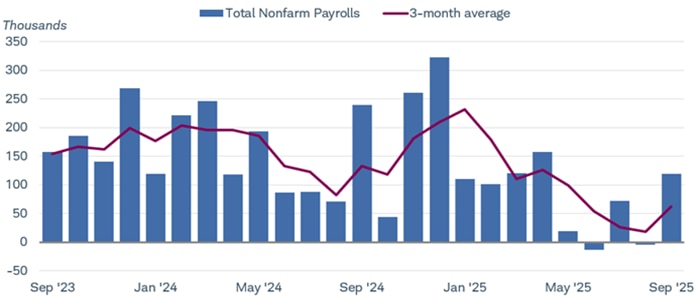
Source: Bloomberg. Monthly data from 9/30/2023 to 9/30/2025, which is the latest data available.
U.S. Employees on Nonfarm Payrolls, Total, MoM, Net Change SA (NFP TCH Index).
However, while hiring has slowed, the current unemployment rate, at 4.4% as of September 2025, is historically low and close to what has generally been considered full employment by many economists. Moreover, average hourly earnings were rising at a 3.8% year-over-year pace in September, according to the Bureau of Labor Statistics, which is higher than the pre-pandemic average.
Overall, the economy looks likely to remain resilient and inflation should persist near 3%, which is significantly above the Fed's 2% target. As we look into 2026, gross domestic product (GDP) growth is likely to remain supported by fiscal stimulus coming from the One Big Beautiful Bill Act, as well as by modestly easier financial conditions courtesy of recent Fed rate cuts. The tax cuts implemented by Congress tend to favor higher-income consumers and corporations, which should keep the economy growing at a rate slightly above the long-term trend of about 2% to 2.5%. Consequently, the Fed doesn't appear to have much room to lower the policy rate. We believe 3% is likely to be a floor.
Overall, we expect 2026 to be another good year of returns for bond investors, but the range of potential outcomes remains wide. We continue to favor a middle-ground strategy—up in quality and intermediate-term average duration—that may help mitigate some of the risks while allowing for potentially attractive returns.
International stocks and economy: Poised to accelerate?
Global economic growth may slow in the near term but then accelerate as 2026 progresses, owing to the lagged effect of interest rate cuts on business and consumer behavior, increased fiscal support, and potentially moving past the peak in tariff uncertainty.
Manufacturing tends to be more cyclical than services and is typically a leading indicator of the overall economy, despite being a smaller segment. The manufacturing component of the JPMorgan Global Purchasing Manager Index (PMI) for November slowed to 50.5 from 50.9, suggesting near-term weakening within an economic expansion (index levels above 50 suggest expansion and below 50 indicate contraction). Forward-looking indicators within the index showed continued growth resiliency, with the new-orders component remaining above 50, the future output component rising, and inventory levels not keeping up with new orders. All these potentially suggest the need to increase manufacturing activity to keep up with expected future demand. Business optimism about the future rose to a five-month high within the November Global Manufacturing PMI.
Manufacturing may need to increase as orders outpace inventories
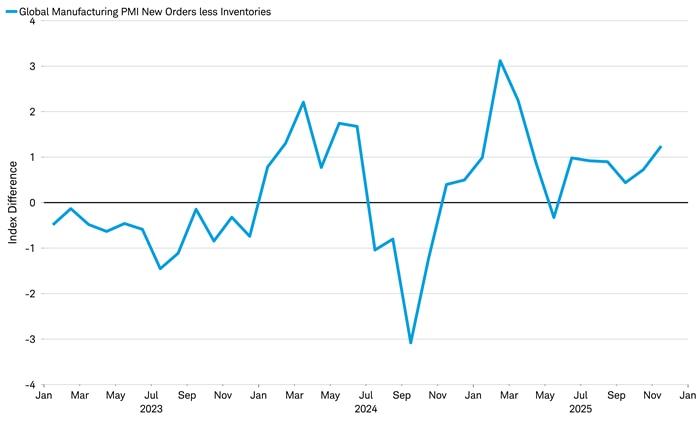
Source: Charles Schwab, S&P Global, Macrobond as of 12/1/2025.
The JPMorgan Global Manufacturing PMI® is compiled by S&P Global in association with the Institute for Supply Management (ISM) and the International Federation of Purchasing and Supply Management (IFPSM). Global manufacturing PMI indices are compiled from responses to monthly questionnaires sent to purchasing managers in survey panels in over 40 regions, totaling around 13,500 companies.
The impact of prior central bank interest rate cuts may filter through the global economy in 2026. Typically, the JPMorgan Global Manufacturing PMI increases about nine months after interest rate cuts, as seen in the following chart.
Interest rate cuts historically have tended to lead to PMI increases
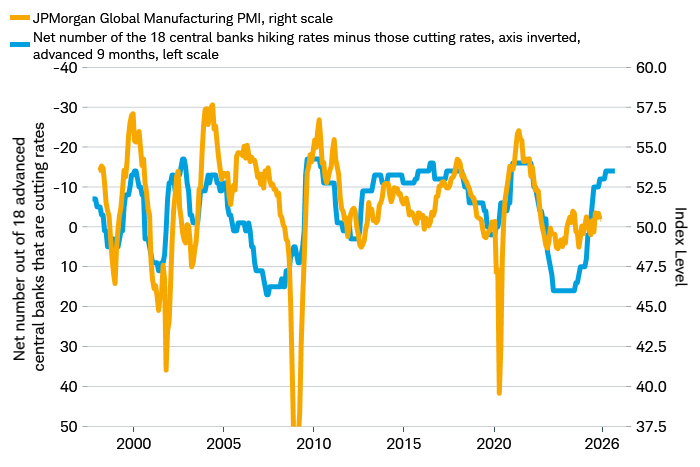
Source: Charles Schwab, S&P Global, Macrobond, as of 12/2/2025.
JPMorgan Global Manufacturing PMI line is truncated for visual purposes; it reached a low point of 33.8 in 12/2008. Forecasts contained herein are for illustrative purposes only, may be based upon proprietary research and are developed through analysis of historical public data.
Manufacturing did not rebound in 2025, in contrast to typical historical patterns. The tariff turmoil created by changes in U.S. trade policy seems to have disrupted the transmission of rate cuts to the global economy. Tariff rates may still change but the initial shock of the huge jump in levies in 2025 is likely in the past.
Meanwhile, valuations are relatively attractive. International stocks as represented by the MSCI EAFE Index tend to trade at a lower valuation relative to the S&P 500 Index due to larger weights in sectors that typically have lower multiples, such as Financials, Industrials, and Materials. However, even looking at historical averages, the MSCI EAFE Index is trading at a 12-month-forward price-to-earnings (P/E) ratio of 15.1 times, close to its 10-year average of 14.5 times, while the S&P 500 is at 22.3 times, well above its 10-year average of 18.7 times, as of December 1st. Additionally, the dividend yield of the MSCI EAFE Index was 2.88%, more than twice the 1.2% of the S&P 500.
As you can see in the chart below, the 12-month-forward P/E of every sector within the MSCI EAFE Index is trading at a discount to the valuation of every sector within the S&P 500 Index. That's despite nearly every MSCI EAFE sector (except Information Technology and Communication Services) outperforming nearly every sector in the S&P 500 during the first 11 months of 2025.
International stocks are less expensive across every sector
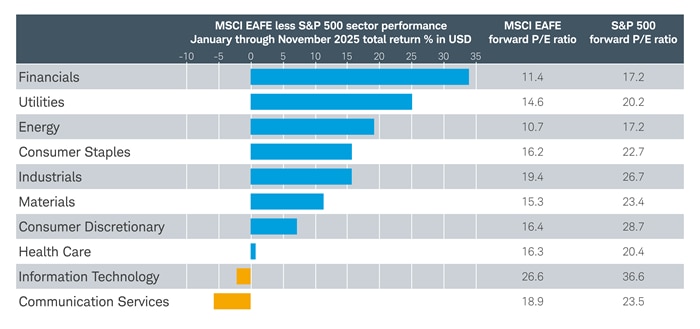
Source: Charles Schwab, MSCI, Macrobond data retrieved 12/2/2025.
Sectors are based on the Global Industry Classification Standard (GICS®), an industry analysis framework developed by MSCI and S&P Dow Jones Indices to provide investors with consistent industry definitions. Indexes are unmanaged, do not incur management fees, costs, and expenses and cannot be invested in directly. Dividends and interest are assumed to have been reinvested, and the example does not reflect the effects of taxes or fees. which would cause performance to be lower. Past performance is no guarantee of future results.
Economic growth could fall short of our forecasts if German fiscal spending underdelivers, inflation globally heats up due to constraints on labor supply and higher prices on imports due to trade protectionism translating to higher costs for manufacturing, or changes to monetary policy that result in higher inflation expectations. But we do believe that international stocks could be poised for another strong year in 2026.